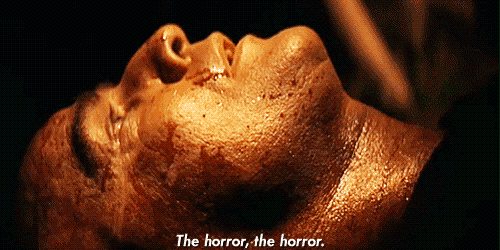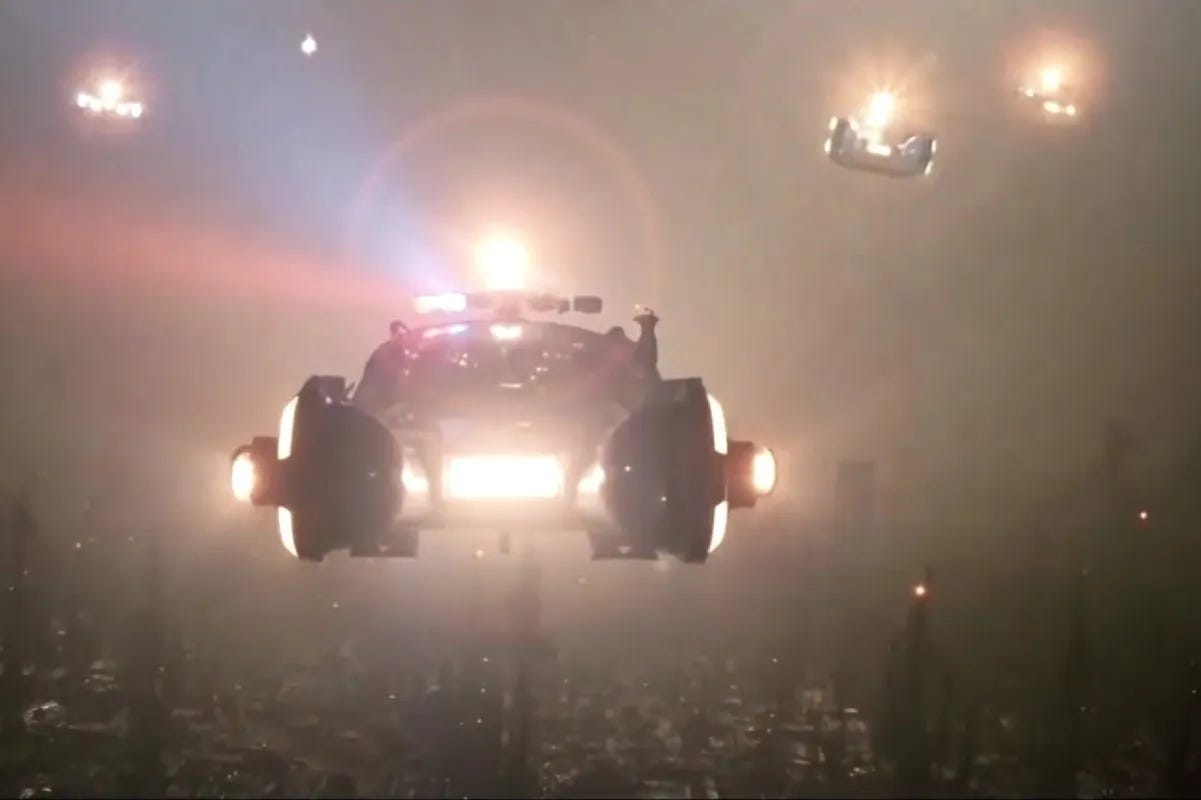The Dark(er) Knight
🔊🦇🔊
It’s been more than four months since I published The New Knighthood. In case you missed it, that was my ponderously long take on the Big Question of our times:
The New Knighthood
“What is to be done?” That seems to be the big question these days. Far from slowing down, our mutual enemy’s movements appear to grow bolder and more destructive by the hour. And while there’s still a lot of debate about what we should do about it, a kind of dismal agreement seems to have formed that we aren’t
Until very recently, “Knighthood” was my most popular essay on Substack. That was likely due in part to its inclusion on the New Right Poast’s list of The 38 Based Reads of 2023 .1 The piece was always intended as prologue, in order to establish a general framework of a “doing-things” network for future posts. I still have the follow-up sitting in my drafts, eyeing me warily over a chalice of frothy mead.
The wariness is proper: We find ourselves at a crossroads; not just politically, but intellectually, technologically and spiritually. The stakes of the next game to be played could not possibly be higher. So, if I’m to add my voice to the camp of strategy then I must be sure in my own mind that any advice I give is sound in theory and practice. And particularly the latter; theorycels played a big role in what got us into this epic trash-fire to begin with and, while ideas and language development can be useful tools, the New Knighthood (or NK) is ultimately about getting shit done.
But something must precede practice, or even the discussion of strategy whatsoever. Before answering “What should we do?” we need to answer the more elemental question of “Who are we?” So, instead of elaborating on the NK’s principles and mechanics, I decided to tell a story about who we are, and how we got here.
It wasn’t a full account, and wasn’t meant to be. My intention was to offer a kind of template, so that others might be inspired to tell the tale of who-and-how in their own unique way. In fact, the retelling of this origin story is an important feature of NK’s conceptual framework as I see it. In addition to specific uses in comms and tactics, it will serve as the spiritual foundation on which your own Knightly House and lineage is built. In other words, my version of the story is also the cornerstone of House Bisone, and the seed of my line. So obviously it’s pretty darn important to me.
The story was also something I heard spoken in my mind’s ear as I typed it. Unless you’ve got full blown anaduralia, I’m sure you’ve experienced much the same thing. Like my writing voice, my inner monologue doesn’t match my speech very well. For one thing, I’m cursed with certain crude, northeastern accent that still occasionally erupts out of nowhere, despite all attempts to suppress it.2
The voice in my skull is a different animal, altogether more composed and clarified. It often sounds like an older version of myself, like some time traveling phantom for whom I’m little more than a stenographer. Other times it sounds like a much younger version, or like the ghost of a twin I absorbed in utero, who only tuned in when old Nat Geo docs were playing. It’s all the same voice, of course, spoken in a variety of dialects. I just happen hear myself differently at times, based on factors known and unknown.
Recently, a subscriber of mine rendered that inner voice of mine in a way I’ve never heard it before. In fact, if you said, “Hey, Mark! Ever wonder what you’d sound like as a rogue British Decepticon plotting a devious cyber-mutiny?” my reaction might’ve been… less than enthusiastic.
And yet?
And yet, this is superb.
The artist behind it goes by the pseudonym
. Accompanying the haunting electric scalpel of his narration is his music, which I’m at a bit of a loss to describe. Is Gothic-Berliner Fairytale Ambience a techno subgenre? While my raver cred is much more solid than you’d think, I admit I’ve been out of that loop for quite some time.But the bells glisten like deadly toys in a midnight attic. Drums lure you gently into range, then roll like a rattlesnake’s dream. There are sudden injections of piano notes, tinkled by a playful phantom who has mastered the offbeats. And running beneath it all, the pulsating purr of something that's massive and warm and alive and rising. Put together, it's like an aural manifestation of the NK code’s second law: Be dangerous.
In short: I’m honored to hear this interpretation of my House’s foundation myth. This track will remain a proud part of its heraldry, for as long as it stands. Heraldry happens to be a big deal in my district of the NK, and so artwork becomes a critical part of its spiritual anatomy as well.
Speaking of art, I think we should all support our own side’s artists monetarily, whenever we’re in the position to do so. Art isn’t just some ephemeral expression of emotion or memetic weapon. It is truth escaping the typical prisons of our Enemy’s mechanistic anti-faith. It often gasps for breath in this depleted posthuman atmosphere, while their side’s con-artists are richly rewarded for their barking and yowling and bootlicking. But although the Enemy still controls the major distribution and marketing organs of the mass “creative” mediums, we have the power of trust and good faith transactions on our side. In the crowdfunding model of patronage, a little can add up to a lot.
In that spirit, consider dropping a few spare coins in
‘s coffers. Look at him as a herald and busker in good standing, for our little quest to save the world. His price for A Walk in the Woods with Bisone Knights is pay-what-you-wish. Quite the bargain, you ask me. Imagine the effect if you all just kicked in a buck — or even one thin dime?An album of his music named Fall is also for sale at his bandcamp site, showcasing the same ambient richness and attention to detail. Even if it’s not your cup of tea, think of it this way: for a measly £3 (or $3.77, ‘Murican), you can help finance one of our team’s bards. That’s less than the cost of a corporate mRNA burger with a side of bioengineered fries!
Either way, we should defo hire this bloke to spin the techno rooms, for our IRL dissident party scene that will eventually, inevitably emerge.
And as long we’re talkin’ all this jive about starving artists and passing the ol’ tip jar, here’s my obligatory request for you to…
A paid subscription would be even better, if you can spare the cash. That way the next time Dame Bisone barges in to inquire about the electric bill, I can say, “Never fear, my darling! I’m paying that sucker off by the syllable.”
That Sucking Sound
⚡🚽🌎
When I was a young man, I used to think that Marcel Duchamp murdered the Western visual arts, and that Andy Warhol then dug up and goosed the corpse. These days I tend to think of both men as comedians. Since comedy is an art form all its own, and because the targets of their jokes and pranks were mostly degenerate nouveau richies and fart-huffing snobs, all was forgiven.
Well, mostly. Some punchlines fall unforgivably flat.
But Duchamp’s most famous joke was Fountain, and it was a genuine hoot. Taking advantage of a certain exhibition’s “anything goes” rule, set in place by a bunch of fellow fart-dealers high on their own supply, the Frenchman bought a wholesale urinal from a factory in Jersey, scribbled “Mutt” on it and dumped it on them anonymously. This entry and its day-of-show suppression “ignited a controversy” in the “art world.” Translation: a bunch of retarded atheists called each other names, in magazines read by gay PUAs and semi-literate posers.
With that in mind here’s another epic potty joke, told in countless bars, restaurants, theaters, hotels, hospitals and office buildings the world over. And now, you can experience this modern technological miracle in the privacy of your own home!
For fewer than a hundred inflated petrobucks, you too can take the “toil” out of toiletry.3
Think of the convenience! Nay, the luxury! Even aristocrats of yore would drool with envy. Never again will you go through the drudgery — and, quite frankly, the trauma — of pushing a small stainless steel handle. Your rising buttcheeks will instead summon forth an infared djinn, to ferry all your seed oil-saturated, microplastics-infused peepees and poopoos into the depths of the River Stynx.
Eat your heart out, King Canute!
Of course, some of the funniest jokes are rooted in a tragedy. For the self-flushing toilet, it’s a kind of heartbreak that’s almost inexpressibly vast. That’s because we’re not mourning the passage of something actual we knew and loved, but a dream that never gained form, never arrived.
And not just one dream, but a entire taxon of dreamscapes, bridging every generation from the Industrial Revolution to the Digital Age. Across that time, these dreams were writ ever larger and with ever more vivid detail. By the time of my birth they’d already escaped the printed page, onto canvases of animated light and orchestral sound. We would break all rules, surpass all speed limits. We wouldn’t just visit the stars, but conquer them. By now, someone would have invented low-G dancing to celebrate our victory.
These innovations wouldn’t mark the end of humanity, but a bold new chapter in our book. We would once again become explorers, frontiersmen, adventurers, missionaries, investigators of the Great Mystery. Even our earthbound lives would be changed for the better. For instance, our enhanced freedom of movement would make it easier to physically connect with each other. If I wanted to visit an old friend in Istanbul or Berlin, I could just hop in my flying car, set the coordinates and, I dunno… read a book, or something silly like that. By the turn of the millennium, sitting in traffic will have gone the way of the buggy whip. We all knew this future was inevitable, back when we were kids.
And so here we are, in 2024. Five years out from this old dream:
Or maybe the world of Ridley Scott’s Blade Runner counts as a nightmare. Scott was particular good at weaving those, showing us how our future innovations could lead to horror. Sadly, only our nightmarish visions of the future have remotely come to pass, and even those are bland and lame. Instead we have Spork Jogger: a sky filled with commercial jets that haven’t seen any significant innovation since before I was born (Unless you count the modern flight school, which churns out “pilots” like McDonald’s churns out cheeseburgers. And even then, they do very little of the actual flying. That’s a job for the boss, as usual).
We have unmanned military drones up there too, of course, and plans to automatize more weapons and surveillance platforms. There’s no need for a Skynet or JOSHUA-style monster. Our monsters are little men and women who sit behind desks, exercising unaccountable and illegitimate authority. The killer robots and oracular AI of their turgid imaginations are simply another means to achieve their prison-state ends.
What other presents did the Ghost of Christmas Future leave for us under the tech tree? A magic mirror toy that sounds like a Wiki-plagiarist, googling its way to a Diversity Studies degree. A broken image blender that spits out Vietnamese Viking chicks and black transgender Nazi popes.
And what’s this? VR goggles, donned to play nauseating, headache-inducing video games. And their AR cousins, to help usher in bracing new geopolitical nightmares at blazing speeds. Remember when a Johnny Mnemonic-style virtual reality wasn’t only the next big thing, but was hovering just around the corner, right next to commercial spaceflight and jetpacks and android butlers and all the rest of it?
I went to see the movie Dune: Part 2 the other night. The theater was practically empty. That’s something a younger version of me might have enjoyed, pretending to be a rich dude at a private screening. Now it just felt lonesome and surreal, like Alex strapped in a cozy version of the Ludovico chair. The seat was adjustable by button-press, which was yet another consumer technology widely available before my birth. This move by the theater-owners reeks of desperation (and from the look of the place, it ain’t working).
But the few others scattered about the theater use it anyway, reclining their heads and kicking back their heels. Earlier that same day I’d been in a hospital, visiting a loved one in desperate straits. His own electric bed was the base of this pariticular tech branch, with doctors seeing much healing utility in it. The thought struck me that my fellow theatergoers were also patients of some kind, afflicted by a nameless syndrome that filled them with the longing to be prone, to fall asleep. I kept my own feet on the ground, for what it’s worth.
Together we watched yet another film about the majestic future. The visuals were exquisitely rendered, and with more intelligence than the typical sci-fi slop they serve up nowadays. The advent of CGI broke the brains of many filmmakers, who seemed to think that littering their frames with digital diarrhea was the best way to keep the audience from falling asleep. But to the director’s credit, the effects of Dune were designed to enhance the storytelling instead of replace it.
Some of them depicted vast machines of exploration and conquest built by a starfaring empire, via industrial and economic means the audience can only guess at.4 As stunning as some of these visions were, a little voice kept reminding me that they’re just fancy cartoons, churned out by virtual sculptors and electric sand. Like a Doomsday preacher, they berate us about what’s soon to arrive, at the doorstep of the actual, on the tip of the tongue. And when it doesn’t, there will be another prediction, and another, and another. So clear your calendars for that Cyber-Rapture, ladies and germs! But till then, keep shoving that popcorn down your gullet.
When the film ends, I hit the men’s room. The bathroom is weirdly big for the number of receptacles it houses. I count three toilet stalls and two urinals in total. The strange math of this doesn’t escape me. Maybe there will be zero urinals soon, no Fountains to be repurposed as fine art for suckers and money laundries. In this looming future, some of the men will sit like ladies to pee. Some of them will even be ladies. But thanks to the march of progress, none of them will need to touch those dirty little handles, ever again.
I zip up and turn away. The sound of the flush is an ASMR ghost, a shy blowjob. It’s the whisper of an ailing Charybdis, whose best days are behind him. I can barely even hear it swirl.
Will wonders never cease?
The Cat Was Never Found is a reader-supported blog. I don’t publish much paywalled content, so your generous patronage is very much appreciated. As a reminder, a paid subscription will also grant you access to Deimos Station; the happiest place in cyberspace!
P.S. If you found any of this valuable (and can spare any change), consider dropping a tip in the cup for ya boy. It will also grant you access to my new “Posts” section on the site, which includes some special paywalled Substack content. Thanks in advance.
I’d encourage all my readers to check that list out. It’s a gourmet feast of extreme, maniacal rightwing dissident excellence. So I was humbled to find my own work plated and served, for which I owe its proprietor
many thanks.That suppression has mainly been for professional reasons, so as not to alarm the delicate hothouse flowers I’m most often hired to assist. And particularly when that hothouse is also sufficiently long, as it so often is these days.
Or at least, not for a few months or so, when this cheaply made hunk of Sino-junk inevitably shits the bed.
Within the context of the film, at least; the source material is quite a bit more detailed.












I find something about virtual reality fascinating. Not the tech itself, which like other things you mentioned has been around for decades. But the fact that adoption has been "just around the corner" for those same decades, yet it never seems to take off... If I was a better philosopher I'd be able to communicate whatever fundamental truth lies at the heart of this. Something along the lines of "virtual realities are ok if they're a small part of actual reality, but the more virtual reality becomes, the more humans turn away." It's like the uncanny valley writ large.
A lot of comment on, Mark, thanks.
But I think I'll start at the top before the tangents (?) to discuss 'what is to be done'. That isn't the question, honestly. There is a word hovering on people's lips, unspoken in the most Queensryche of ways. It makes its way into movies made, if incoherently, by the guy who made Ex Machina...he seems to make cautionary tales. It was a nightmare shown on screens years earlier, spawning a series of sequels that sometimes got better and sometimes got worse from the first installment. Open world video games have the 'bad guys' saying the word and they end up being a memeable musical hit.
It was talked about a lot in the Trump years, in the Before Times, and in the long-long ago, though it was mostly limited to what were quaintly called 'survivalists' back then. There was lots of big talk, talk about 'the three boxes' and 'my oath has no end date' and a bunch of other blustery chickenshit. No one's talking now. Everyone's afraid to talk, to say the word, far more afraid to do the deeds.
Who knows who might be listening? The Intel agencies designed to protect us* have been turned against its citizens, those elected to represent us have decided they're rather rule us, the department of Justice peddle lawlessness, and many judges are corrupt idealogues indoctrinated bought off by billionaires who stopped hiding. James Bond is after us, not after them.
No one will say the word. But we all feel it. We haven't traded freedom for security, we've traded freedom for fear, weakness, cowardice with cookies and a quiet home.
Me? I prayed deeply and sincerely and the answer I got was 'no'. Deus Vult. All things die, even nations. All part of the plan. Live not for this world. And so on, what comfort there is, there is only in faith. Put your trust not in princes, nor in fellow citizens, nor in your ex-soldiers.
But...I'm going to keep humming the Hope County Choir, and I carry. If fiction becomes reality, I "hope" I won't go quietly.
*(if that was what they were created for, the more 'illuminated' always suspected they were intended to be a semi-secret power behind the throne, the mailed fist hidden, like the Federal Reserve, in plain sight like eyes in pyramids)